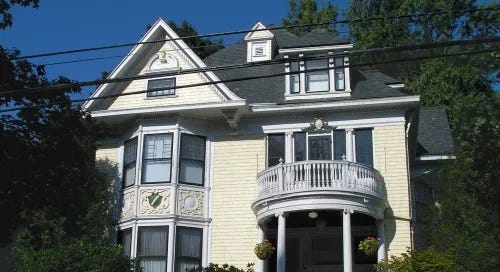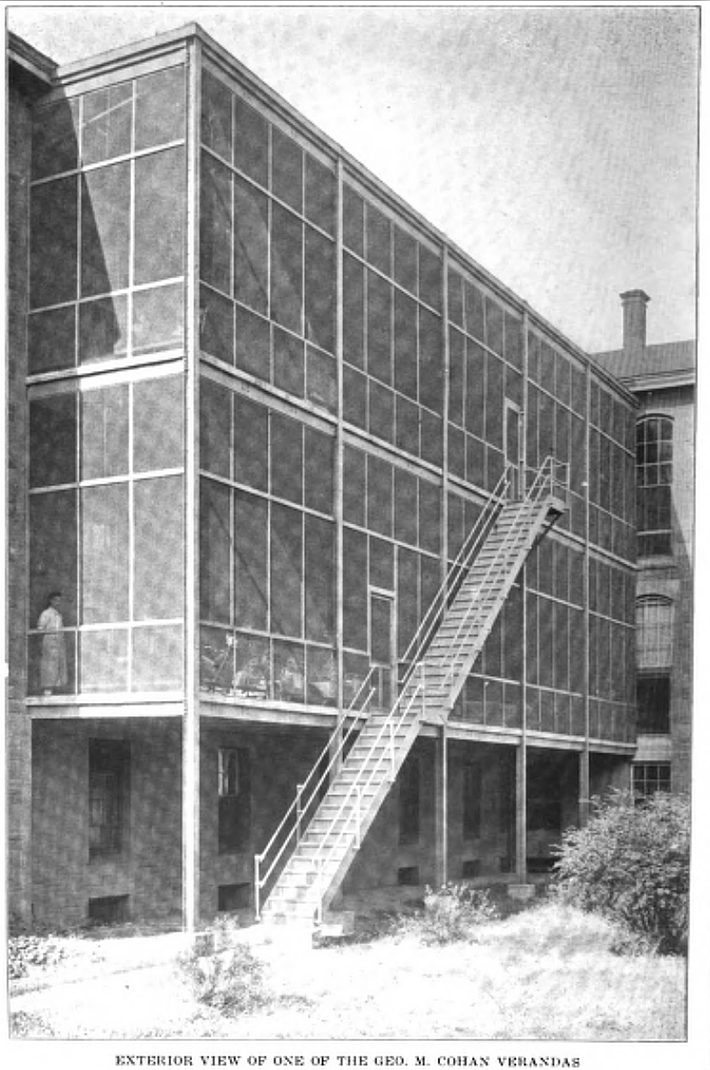Yesterday I had the pleasure of giving a group of employees of RTX a tour of the West End of Hartford. One of the many architecturally distinguished homes I pointed out was 65 Kenyon Street. Built in 1900, it’s a Queen Anne-style house with many Colonial Revival details, including the columned front entrance portico. The house’s original owner was Charles H. Atkins, who lost the house to foreclosure in 1909. The next owner was James H. Cooke. According to a history of the house (still available as a pdf file on the old Kenyon Street website), Cooke was the proud owner of “a Pierce Arrow with a rumble seat in the back,” and it was likely Cooke who replaced “the original one-car garage with a larger two-car, heated garage,” complete with a grease pit.
Cooke was superintendent of the Connecticut Trap Rock Company, which had its headquarters in Middlefield and also owned additional quarries in Meriden and New Britain. He clearly loved his automobile and must have used it often to travel between Hartford and the company’s quarries. He also experienced the dangers of driving in those early days of motoring, as revealed in reports on two separate incidents in the Hartford Courant. The first accident, which happened in New Britain, was described in the paper on August 10, 1911:
James H. Cooke of No. 65 Kenyon street, Hartford, ran into a 6 years old girl, Margaret Kilduff, daughter of Mr. and Mrs. Edward Kilduff of Allen street, while driving his machine through Stanley Quarter about 4 o'clock this afternoon. The machine knocked the child down and broke her right leg. She was picked up by Mr. Cooke and taken to the office of Dr. E. P. Swasey, where Drs. Swasey and Strosser set the bone. She was then removed to the New Britain General Hospital. The leg was broken above the knee.
According to Mr. Cooke he was driving through North Stanley street at a slow rate of speed on his way to Hartford. Near the house of Charles S. Andrews two little girls were sitting on a bank beside the road and one of them ran from the rear of an ice wagon which was approaching him from Hartford in front of his automobile. The child was trying to cross the street and continued on, so that he was unable to dodge her, in spite of the fact that he attempted to turn it to one side. He said that he did not notice the child in the road until she ran from the rear of the ice wagon and that then he had no opportunity to avoid the accident.
Mr. Cooke took the child's mother to the hospital and did all he could for the family. It was said at the hospital tonight that the child was resting comfortably. According to some witnesses of the accident, the auto was going pretty fast. The police will investigate the matter. No arrest was made.
A little over two years later, Cooke had another accident. The description in the Courant, reported on September 29, 1913, brings to mind the fact that touring cars were usually open-air vehicles and, of course, had no seat belts:
A touring car owned and driven by James H. Cooke of No. 85 Kenyon street, became unmanageable on the Berlin turnpike late Saturday afternoon when Mr. Cooke and a party of five others were returning from the stone quarries in Middlefield, und struck a telegraph pole, severely injuring Mrs. Cooke, who was removed to the Hartford Hospital, and bruising and shaking up the other members of the party. Mrs. Cooke is suffering from a fractured thigh, cuts about the face and bruised about the body. She will recover.
The six in the automobile at the time of the accident were Mr. and Mrs. Cooke, their children, Theodore, Mildred and Constance und Miss Florence Arnold of Wethersfield, a friend of the family. Mrs. Cooke, Mildred and Constance, the 14-months-old baby, were on the rear seat at the time of the crash. These three were hurled out, falling in the roadway. The occupants of the front seat felt the shock of the impact but were not injured.
The right forward tire of the machine was flat and Mr. Cooke attributes the accident to this. When the heavy machine began to swerve he was unable to bring it to a stop, with the result that the car left the road at a spot which is crowned especially sharp, and struck a telegraph pole. The pole was cut clean, according to Mr. Cooke and members of another automobile party which came up shortly after the accident. There were three poles in close succession where the accident occurred and the machine struck the last of these three.
The Courant article also notes that about three weeks earlier, and about a mile to the south, the famous George M. Cohan had also had an auto accident on the Berlin Turnpike when his Packard touring car overturned after colliding with a garbage wagon. On his way to Hartford for rehearsals of his latest play, “Seven Keys to Baldpate,” Cohan and the four other members of his party, one of whom was his 13-year-old daughter, were all thrown from the vehicle. I mention this incident in my video about the history of the buildings of Hartford Hospital because, as with James Cooke’s party, the victims were taken to the hospital. Cohan broke his shoulder and his daughter suffered a skull fracture. The entertainer and playwright was so pleased with the treatment they received during their 2-week stay at the hospital that he returned to Hartford a year later to present a benefit performance of his new play for 1914, “The Miracle Man,” at the Parsons Theater. Part of the money raised by the performance was used in 1915 to erect the George M. Cohan verandas along the exteriors of two of the hospital’s wards.
.






